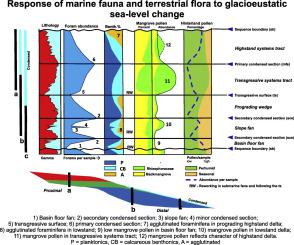当前位置:
X-MOL 学术
›
Palaeogeogr. Palaeoclimatol. Palaeoecol.
›
论文详情
Our official English website, www.x-mol.net, welcomes your feedback! (Note: you will need to create a separate account there.)
Sequence biostratigraphic framework for the Oligocene to Pliocene of Malaysia: High-frequency depositional cycles driven by polar glaciation
Palaeogeography, Palaeoclimatology, Palaeoecology ( IF 3 ) Pub Date : 2021-01-01 , DOI: 10.1016/j.palaeo.2020.110058 Robert J. Morley , Sanatul Salwa Hasan , Harsanti P. Morley , Jaizan Hardi M. Jais , Amiruddin Mansor , M. Raziken Aripin , M. Hafiz Nordin , M. Helmi Rohaizar
Palaeogeography, Palaeoclimatology, Palaeoecology ( IF 3 ) Pub Date : 2021-01-01 , DOI: 10.1016/j.palaeo.2020.110058 Robert J. Morley , Sanatul Salwa Hasan , Harsanti P. Morley , Jaizan Hardi M. Jais , Amiruddin Mansor , M. Raziken Aripin , M. Hafiz Nordin , M. Helmi Rohaizar

|
Abstract This paper reviews quantitative biostratigraphic data from 101 petroleum exploration wells from the Malay, Sarawak and Sabah basins, and places the stratigraphy of each area into a precise chronostratigraphic framework comprising 41 transgressive-regressive depositional packages which are fully defined here. Each package is ‘fingerprinted’ by foraminiferal, nannofossil and palynological index fossils, and then tied to the global pattern of glacio-eustatic sea level and climate changes based on the global δ18O and δ13C datasets used to calibrate the geological timescale. The result is a tightly constrained chronostratigraphic framework that is applicable from deep to shallow water and is of high accuracy. It is concluded that there is a sedimentation ‘pulsebeat’ across Southeast Asia, independent of local and regional tectonics, driven by patterns of global climate change. For the Oligocene and Miocene, Antarctic glaciation is the key driver, whereas the Pliocene cycles are mainly driven by the expansion and contraction of Northern Hemisphere glaciers. The new chronostratigraphic framework allows unconformities across Malaysia to be better characterised, and the different classification schemes of seismic “Groups” in Malay and Penyu basins, “Cycles” in offshore Sarawak and “Stages” in offshore western Sabah to be correlated. Also, with a clear understanding of the effect of fluctuating sea levels on the stratigraphy of the region, it is easier to make firm judgments regarding the effect of tectonics. The study also characterises systems tracts from shelf to basin floor using biostatigraphic assemblages, which should help in ground-truthing the architecture of depositional sequences in the region based on seismic. The new framework is proposed as an alternative to the outdated TB scheme of Haq et al. (1988) , widely used to interpret depositional cycles across Sarawak and Sabah.
中文翻译:

马来西亚渐新世至上新世序列生物地层框架:极地冰川驱动的高频沉积循环
摘要 本文回顾了来自马来、砂拉越和沙巴盆地 101 口石油勘探井的定量生物地层数据,并将每个地区的地层置于一个精确的年代地层框架中,该框架由 41 个海侵-海退沉积包组成,这里完全定义。每个包都由有孔虫、纳米化石和孢粉学指数化石“指纹”,然后根据用于校准地质时间尺度的全球 δ18O 和 δ13C 数据集,与全球冰川-海平面和气候变化模式相关联。结果是一个严格约束的年代地层框架,适用于从深水到浅水,并且精度很高。结论是整个东南亚存在沉积“脉动”,独立于当地和区域构造,受全球气候变化模式驱动。对于渐新世和中新世,南极冰川作用是关键驱动因素,而上新世周期则主要由北半球冰川的扩张和收缩驱动。新的年代地层框架可以更好地表征马来西亚各地的不整合面,并将马来盆地和 Penyu 盆地的地震“群”、砂拉越近海的“旋回”和沙巴西部近海的“阶段”的不同分类方案相互关联。此外,清楚地了解海平面波动对该地区地层的影响,就更容易对构造的影响做出明确的判断。该研究还使用生物统计组合描述了从陆架到盆地底部的系统区域,这应该有助于基于地震对该地区沉积序列的结构进行实地验证。新框架被提议作为 Haq 等人过时的结核病方案的替代方案。(1988),广泛用于解释横跨砂拉越和沙巴的沉积循环。
更新日期:2021-01-01
中文翻译:

马来西亚渐新世至上新世序列生物地层框架:极地冰川驱动的高频沉积循环
摘要 本文回顾了来自马来、砂拉越和沙巴盆地 101 口石油勘探井的定量生物地层数据,并将每个地区的地层置于一个精确的年代地层框架中,该框架由 41 个海侵-海退沉积包组成,这里完全定义。每个包都由有孔虫、纳米化石和孢粉学指数化石“指纹”,然后根据用于校准地质时间尺度的全球 δ18O 和 δ13C 数据集,与全球冰川-海平面和气候变化模式相关联。结果是一个严格约束的年代地层框架,适用于从深水到浅水,并且精度很高。结论是整个东南亚存在沉积“脉动”,独立于当地和区域构造,受全球气候变化模式驱动。对于渐新世和中新世,南极冰川作用是关键驱动因素,而上新世周期则主要由北半球冰川的扩张和收缩驱动。新的年代地层框架可以更好地表征马来西亚各地的不整合面,并将马来盆地和 Penyu 盆地的地震“群”、砂拉越近海的“旋回”和沙巴西部近海的“阶段”的不同分类方案相互关联。此外,清楚地了解海平面波动对该地区地层的影响,就更容易对构造的影响做出明确的判断。该研究还使用生物统计组合描述了从陆架到盆地底部的系统区域,这应该有助于基于地震对该地区沉积序列的结构进行实地验证。新框架被提议作为 Haq 等人过时的结核病方案的替代方案。(1988),广泛用于解释横跨砂拉越和沙巴的沉积循环。


























 京公网安备 11010802027423号
京公网安备 11010802027423号